2023届高三英语一轮复习定语从句课件(12张ppt)
文档属性
| 名称 | 2023届高三英语一轮复习定语从句课件(12张ppt) | 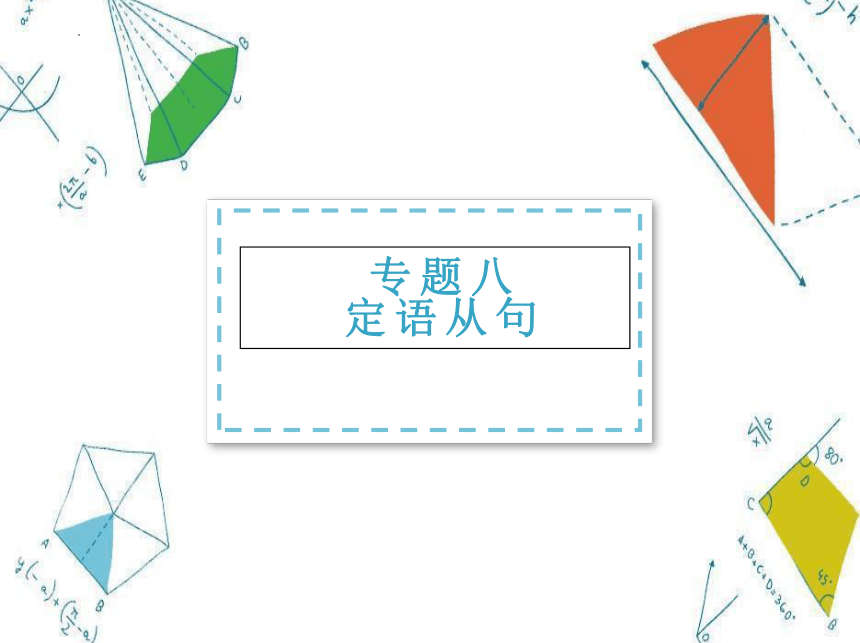 | |
| 格式 | pptx | ||
| 文件大小 | 814.8KB | ||
| 资源类型 | 教案 | ||
| 版本资源 | 通用版 | ||
| 科目 | 英语 | ||
| 更新时间 | 2022-10-28 21:44:42 | ||
图片预览

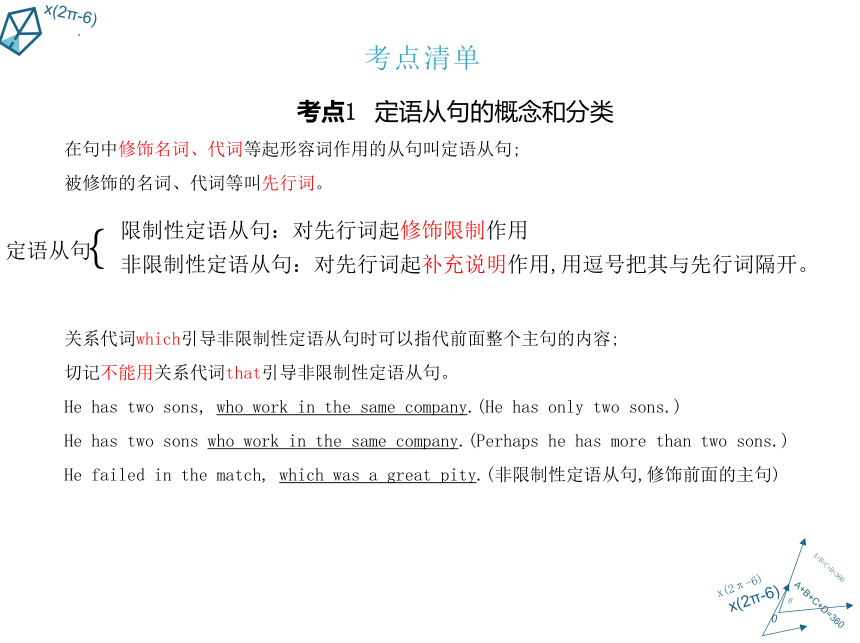
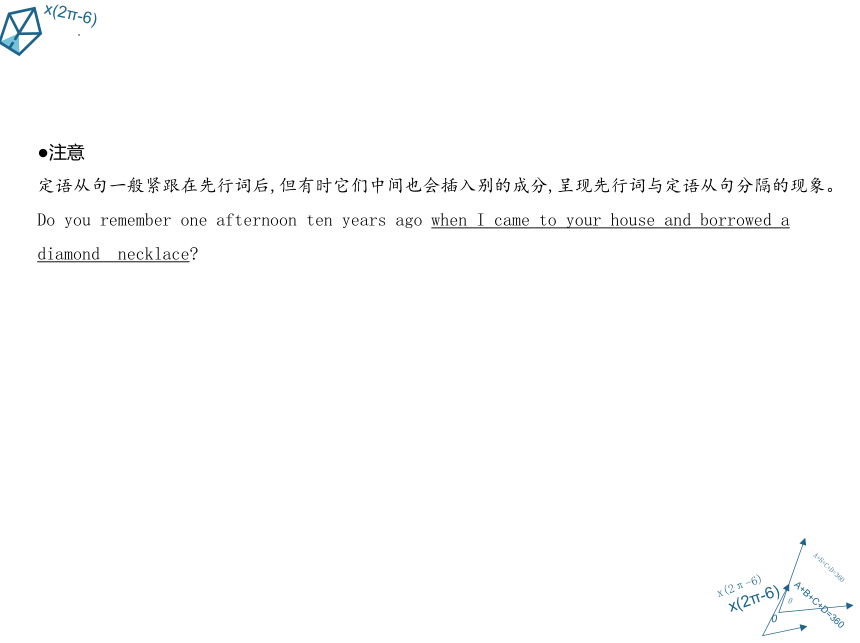
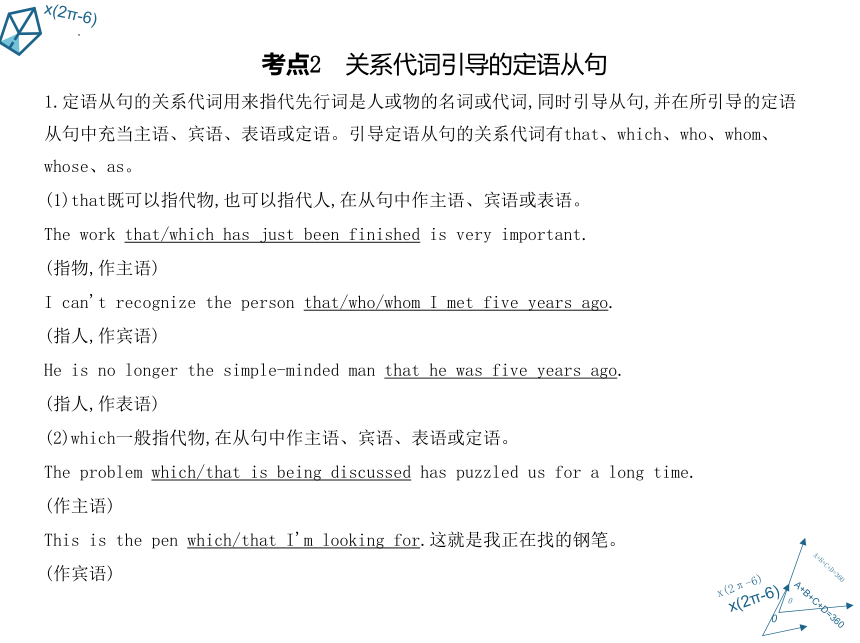
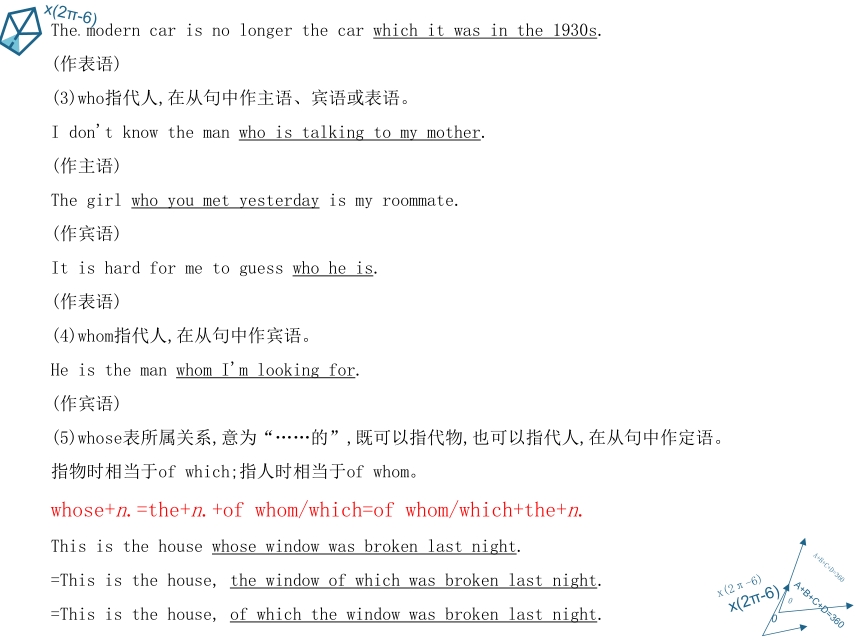
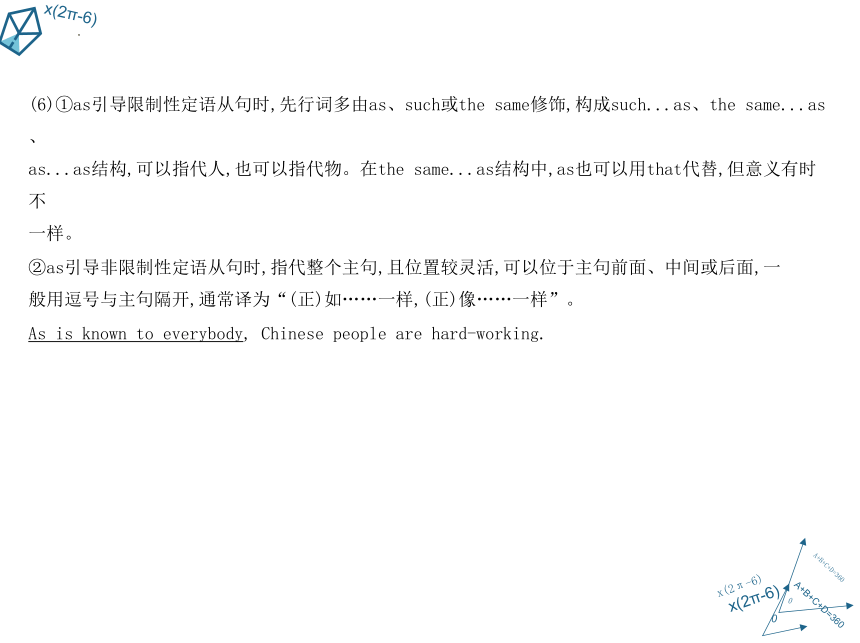
文档简介
(共12张PPT)
专题八
定语从句
0
A+B+C+D=360
x(2π-6)
考点1 定语从句的概念和分类
在句中修饰名词、代词等起形容词作用的从句叫定语从句;
被修饰的名词、代词等叫先行词。
{
关系代词which引导非限制性定语从句时可以指代前面整个主句的内容;
切记不能用关系代词that引导非限制性定语从句。
He has two sons, who work in the same company.(He has only two sons.)
He has two sons who work in the same company.(Perhaps he has more than two sons.)
He failed in the match, which was a great pity.(非限制性定语从句,修饰前面的主句)
考点清单
限制性定语从句:对先行词起修饰限制作用
非限制性定语从句:对先行词起补充说明作用,用逗号把其与先行词隔开。
定语从句
0
A+B+C+D=360
x(2π-6)
●注意
定语从句一般紧跟在先行词后,但有时它们中间也会插入别的成分,呈现先行词与定语从句分隔的现象。
Do you remember one afternoon ten years ago when I came to your house and borrowed a
diamond necklace
0
A+B+C+D=360
x(2π-6)
考点2 关系代词引导的定语从句
1.定语从句的关系代词用来指代先行词是人或物的名词或代词,同时引导从句,并在所引导的定语
从句中充当主语、宾语、表语或定语。引导定语从句的关系代词有that、which、who、whom、
whose、as。
(1)that既可以指代物,也可以指代人,在从句中作主语、宾语或表语。
The work that/which has just been finished is very important.
(指物,作主语)
I can't recognize the person that/who/whom I met five years ago.
(指人,作宾语)
He is no longer the simple-minded man that he was five years ago.
(指人,作表语)
(2)which一般指代物,在从句中作主语、宾语、表语或定语。
The problem which/that is being discussed has puzzled us for a long time.
(作主语)
This is the pen which/that I'm looking for.这就是我正在找的钢笔。
(作宾语)
0
A+B+C+D=360
x(2π-6)
The modern car is no longer the car which it was in the 1930s.
(作表语)
(3)who指代人,在从句中作主语、宾语或表语。
I don't know the man who is talking to my mother.
(作主语)
The girl who you met yesterday is my roommate.
(作宾语)
It is hard for me to guess who he is.
(作表语)
(4)whom指代人,在从句中作宾语。
He is the man whom I'm looking for.
(作宾语)
(5)whose表所属关系,意为“……的”,既可以指代物,也可以指代人,在从句中作定语。
指物时相当于of which;指人时相当于of whom。
whose+n.=the+n.+of whom/which=of whom/which+the+n.
This is the house whose window was broken last night.
=This is the house, the window of which was broken last night.
=This is the house, of which the window was broken last night.
0
A+B+C+D=360
x(2π-6)
(6)①as引导限制性定语从句时,先行词多由as、such或the same修饰,构成such...as、the same...as、
as...as结构,可以指代人,也可以指代物。在the same...as结构中,as也可以用that代替,但意义有时不
一样。
②as引导非限制性定语从句时,指代整个主句,且位置较灵活,可以位于主句前面、中间或后面,一
般用逗号与主句隔开,通常译为“(正)如……一样,(正)像……一样”。
As is known to everybody, Chinese people are hard-working.
0
A+B+C+D=360
x(2π-6)
●注意
as的习惯用法如下:
as the old saying goes老话说得好
as is often the case通常的情况是
as anybody can see正如人人都能看到的那样
as is well-known=as is known to all众所周知
as we had expected正如我们所预料的那样
as often happens正如经常发生的那样
as has been said before如上所述
as is mentioned above正如上面所提到的
0
A+B+C+D=360
x(2π-6)
2.“介词+关系代词”的用法
(1)“介词+关系代词”引导定语从句时,关系代词只能用which或whom,且不能省略。
①选择介词时,主要看它与先行词及从句中的动词或形容词等的搭配。
I saw a woman running toward me in the dark.Before I could recognize who she was, she had run back in the direction from which she had come.
②选择关系代词时,先行词是物,只能用which;先行词是人,只能用whom。
In our class there are 46 students, of whom half wear glasses.
③有时为了表述得更准确些,还常常在“介词+关系代词”结构前加一些代词、名词、数词等。
It is reported that two schools, both of which are being built in my hometown, will open next year.
0
A+B+C+D=360
x(2π-6)
3.关系代词的省略
(1)关系代词在引导定语从句时,如果在从句中作宾语,可以省略。
The man (that/who/whom) you saw just now is our manager.
(2)关系代词如果紧跟在介词后面,则不能省略;但介词位于句尾时,关系代词可以省略。
This is the girl with whom he worked. (whom不可省)
=This is the girl (whom) he worked with.这就是
0
A+B+C+D=360
x(2π-6)
人和物共同作先行词时 Do you know the things and persons that they are talking about
先行词为all、much、little、something、everything、anything、nothing、none、one等不定代词时 Do you have anything that you want to say for yourself
You should hand in all that you have.
先行词被the only、the very(恰恰,正好)、any、few、little、no、all等修饰时 This is the very bus that I'm waiting for
The only thing that we can do is to
give you some money.
先行词前有最高级修饰时 This is the best way that has been
used against pollution.
先行词前有序数词修饰或先行词为序数词 What is the first American film that you have seen
主句的主语是疑问词who或which时 Which is the book that you lost
Who is the boy that won the gold
medal
4.只用that而不用which的情况
0
A+B+C+D=360
x(2π-6)
考点3 关系副词引导的定语从句
关系副词引导定语从句,并在从句中表示时间、地点或原因等。关系副词相当于“介词+which”,
其用法如下:
He will always remember the day when/on which his father returned from the front.
The book store where/in which his sister works is the largest one in Nanjing.
I don't know the reason why/for which he didn't come last night.
关系副词 被替代的先行词 在从句中的功能
when 表示时间的名词 作时间状语
where 表示地点的名词 作地点状语
why 只有reason 作原因状语
0
A+B+C+D=360
x(2π-6)
●注意
①当way作先行词表示方法、方式且定语从句中缺少状语时,后面的定语从句用that或in which,也
可以省略关系词。
I don't like the way you talk to your parents.
②一些名词是抽象的地点,其后面的定语从句如果缺少状语时,用where引导定语从句,常见的这类
名词有family、job、work、situation、case、condition、point、stage等。
There comes a point where you give up.
③occasion和interval后面的定语从句常用when引导。
There was an occasion when he was invited to deliver a lecture on genetic engineering.
专题八
定语从句
0
A+B+C+D=360
x(2π-6)
考点1 定语从句的概念和分类
在句中修饰名词、代词等起形容词作用的从句叫定语从句;
被修饰的名词、代词等叫先行词。
{
关系代词which引导非限制性定语从句时可以指代前面整个主句的内容;
切记不能用关系代词that引导非限制性定语从句。
He has two sons, who work in the same company.(He has only two sons.)
He has two sons who work in the same company.(Perhaps he has more than two sons.)
He failed in the match, which was a great pity.(非限制性定语从句,修饰前面的主句)
考点清单
限制性定语从句:对先行词起修饰限制作用
非限制性定语从句:对先行词起补充说明作用,用逗号把其与先行词隔开。
定语从句
0
A+B+C+D=360
x(2π-6)
●注意
定语从句一般紧跟在先行词后,但有时它们中间也会插入别的成分,呈现先行词与定语从句分隔的现象。
Do you remember one afternoon ten years ago when I came to your house and borrowed a
diamond necklace
0
A+B+C+D=360
x(2π-6)
考点2 关系代词引导的定语从句
1.定语从句的关系代词用来指代先行词是人或物的名词或代词,同时引导从句,并在所引导的定语
从句中充当主语、宾语、表语或定语。引导定语从句的关系代词有that、which、who、whom、
whose、as。
(1)that既可以指代物,也可以指代人,在从句中作主语、宾语或表语。
The work that/which has just been finished is very important.
(指物,作主语)
I can't recognize the person that/who/whom I met five years ago.
(指人,作宾语)
He is no longer the simple-minded man that he was five years ago.
(指人,作表语)
(2)which一般指代物,在从句中作主语、宾语、表语或定语。
The problem which/that is being discussed has puzzled us for a long time.
(作主语)
This is the pen which/that I'm looking for.这就是我正在找的钢笔。
(作宾语)
0
A+B+C+D=360
x(2π-6)
The modern car is no longer the car which it was in the 1930s.
(作表语)
(3)who指代人,在从句中作主语、宾语或表语。
I don't know the man who is talking to my mother.
(作主语)
The girl who you met yesterday is my roommate.
(作宾语)
It is hard for me to guess who he is.
(作表语)
(4)whom指代人,在从句中作宾语。
He is the man whom I'm looking for.
(作宾语)
(5)whose表所属关系,意为“……的”,既可以指代物,也可以指代人,在从句中作定语。
指物时相当于of which;指人时相当于of whom。
whose+n.=the+n.+of whom/which=of whom/which+the+n.
This is the house whose window was broken last night.
=This is the house, the window of which was broken last night.
=This is the house, of which the window was broken last night.
0
A+B+C+D=360
x(2π-6)
(6)①as引导限制性定语从句时,先行词多由as、such或the same修饰,构成such...as、the same...as、
as...as结构,可以指代人,也可以指代物。在the same...as结构中,as也可以用that代替,但意义有时不
一样。
②as引导非限制性定语从句时,指代整个主句,且位置较灵活,可以位于主句前面、中间或后面,一
般用逗号与主句隔开,通常译为“(正)如……一样,(正)像……一样”。
As is known to everybody, Chinese people are hard-working.
0
A+B+C+D=360
x(2π-6)
●注意
as的习惯用法如下:
as the old saying goes老话说得好
as is often the case通常的情况是
as anybody can see正如人人都能看到的那样
as is well-known=as is known to all众所周知
as we had expected正如我们所预料的那样
as often happens正如经常发生的那样
as has been said before如上所述
as is mentioned above正如上面所提到的
0
A+B+C+D=360
x(2π-6)
2.“介词+关系代词”的用法
(1)“介词+关系代词”引导定语从句时,关系代词只能用which或whom,且不能省略。
①选择介词时,主要看它与先行词及从句中的动词或形容词等的搭配。
I saw a woman running toward me in the dark.Before I could recognize who she was, she had run back in the direction from which she had come.
②选择关系代词时,先行词是物,只能用which;先行词是人,只能用whom。
In our class there are 46 students, of whom half wear glasses.
③有时为了表述得更准确些,还常常在“介词+关系代词”结构前加一些代词、名词、数词等。
It is reported that two schools, both of which are being built in my hometown, will open next year.
0
A+B+C+D=360
x(2π-6)
3.关系代词的省略
(1)关系代词在引导定语从句时,如果在从句中作宾语,可以省略。
The man (that/who/whom) you saw just now is our manager.
(2)关系代词如果紧跟在介词后面,则不能省略;但介词位于句尾时,关系代词可以省略。
This is the girl with whom he worked. (whom不可省)
=This is the girl (whom) he worked with.这就是
0
A+B+C+D=360
x(2π-6)
人和物共同作先行词时 Do you know the things and persons that they are talking about
先行词为all、much、little、something、everything、anything、nothing、none、one等不定代词时 Do you have anything that you want to say for yourself
You should hand in all that you have.
先行词被the only、the very(恰恰,正好)、any、few、little、no、all等修饰时 This is the very bus that I'm waiting for
The only thing that we can do is to
give you some money.
先行词前有最高级修饰时 This is the best way that has been
used against pollution.
先行词前有序数词修饰或先行词为序数词 What is the first American film that you have seen
主句的主语是疑问词who或which时 Which is the book that you lost
Who is the boy that won the gold
medal
4.只用that而不用which的情况
0
A+B+C+D=360
x(2π-6)
考点3 关系副词引导的定语从句
关系副词引导定语从句,并在从句中表示时间、地点或原因等。关系副词相当于“介词+which”,
其用法如下:
He will always remember the day when/on which his father returned from the front.
The book store where/in which his sister works is the largest one in Nanjing.
I don't know the reason why/for which he didn't come last night.
关系副词 被替代的先行词 在从句中的功能
when 表示时间的名词 作时间状语
where 表示地点的名词 作地点状语
why 只有reason 作原因状语
0
A+B+C+D=360
x(2π-6)
●注意
①当way作先行词表示方法、方式且定语从句中缺少状语时,后面的定语从句用that或in which,也
可以省略关系词。
I don't like the way you talk to your parents.
②一些名词是抽象的地点,其后面的定语从句如果缺少状语时,用where引导定语从句,常见的这类
名词有family、job、work、situation、case、condition、point、stage等。
There comes a point where you give up.
③occasion和interval后面的定语从句常用when引导。
There was an occasion when he was invited to deliver a lecture on genetic engineering.
